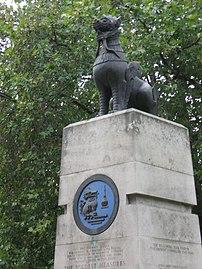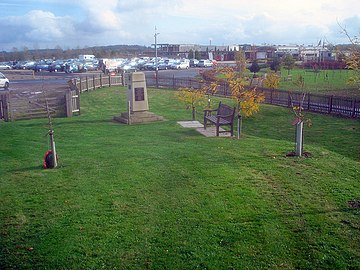
The Chindits, officially known as Long Range Penetration Groups, were special operations units of the British and Indian armies which saw action in 1943–1944 during the Burma Campaign of World War II. Brigadier Orde Wingate formed them for long-range penetration operations against the Imperial Japanese Army, especially attacking lines of communication deep behind Japanese lines.
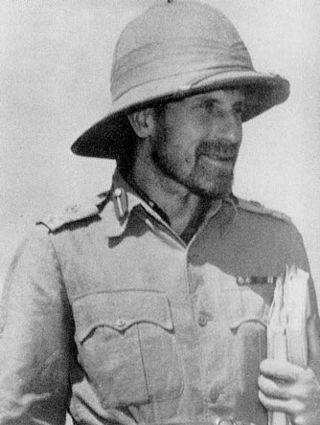
Major General Orde Charles Wingate, was a senior British Army officer known for his creation of the Chindit deep-penetration missions in Japanese-held territory during the Burma Campaign of the Second World War.

The South Staffordshire Regiment was a line infantry regiment of the British Army in existence for only 68 years. The regiment was created in 1881 under the Childers Reforms by the amalgamation of the 38th Regiment of Foot and the 80th Regiment of Foot. The regiment saw service in the Second Boer War, World War I and World War II.

Michael Allmand VC was an English Second World War recipient of the Victoria Cross, the highest and most prestigious award for gallantry in the face of the enemy that can be awarded to British and Commonwealth forces.
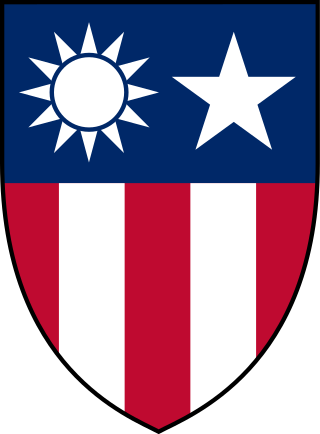
China Burma India Theater (CBI) was the United States military designation during World War II for the China and Southeast Asian or India–Burma (IBT) theaters. Operational command of Allied forces in the CBI was officially the responsibility of the Supreme Commanders for South East Asia or China. In practice, U.S. forces were usually overseen by General Joseph Stilwell, the Deputy Allied Commander in China; the term "CBI" was significant in logistical, material and personnel matters; it was and is commonly used within the US for these theaters.

Lieutenant General Walter David Alexander Lentaigne,, also known as Joe Lentaigne, was a senior officer in the British Indian Army.

Lieutenant George Albert Cairns VC was a British Army officer and an English recipient of the Victoria Cross (VC), the highest award for gallantry in the face of the enemy that can be awarded to British and Commonwealth forces.

Brigadier James Michael Calvert, was a British Army officer who was involved in special operations in Burma during the Second World War. He participated in both Chindit operations and was instrumental in popularizing the unorthodox ideas of Orde Wingate. He frequently led attacks from the front, a practice that earned him the nickname amongst the men under his command of "Mad Mike."

Brigadier Bernard Edward Fergusson, Baron Ballantrae, was a British Army officer and military historian who served as the tenth governor-general of New Zealand from 1962 to 1967. He was the last British-born person to hold the position.

Chinthe ; Shan: သၢင်ႇသီႈ ) is the Burmese word for 'lion'. The leograph of Chinthe is a highly stylized lion commonly depicted in Burmese iconography and architecture, especially as a pair of guardians flanking the entrances of Buddhist pagodas and kyaung.

The Women's Auxiliary Service (Burma) (WAS(B)) also known as the Chinthe Women because of the mythological creature that formed their badge. The unit was formed on 16 January 1942 and disbanded in 1946. They were a 250 strong group of British and Australian women who operated mobile canteens for the troops of Burma Command in World War II. They were founded and led by Mrs Ninian Taylor, who was granted the rank of Major and her services were an OBE for her services.

The 1st Special Operations Wing at Hurlburt Field, Florida is one of three United States Air Force active duty Special Operations wings and falls under the Air Force Special Operations Command (AFSOC).

The Border Regiment was a line infantry regiment of the British Army, which was formed in 1881 under the Childers Reforms by the amalgamation of the 34th (Cumberland) Regiment of Foot and the 55th (Westmorland) Regiment of Foot.
A long-range penetration patrol, group, or force is a special operations unit capable of operating long distances behind enemy lines far away from direct contact with friendly forces as opposed to a Long Range Reconnaissance Patrol, a small group primarily engaged in scouting missions.

The Burma campaign in the South-East Asian Theatre of World War II took place over four years from 1942 to 1945. During the first year of the campaign, the Imperial Japanese Army with aid from Burmese insurgents had driven British forces and Chinese forces out of Burma, and occupied most of the country. From May to December 1942, most active campaigning ceased as the monsoon rains made tactical movement almost impossible in the forested and mountainous border between India and Burma, and both the Allies and Japanese faced severe logistical constraints.

The fighting in the Burma campaign in 1944 was among the most severe in the South-East Asian Theatre of World War II. It took place along the borders between Burma and India, and Burma and China, and involved the British Commonwealth, Chinese and United States forces, against the forces of Imperial Japan and the Indian National Army. British Commonwealth land forces were drawn primarily from the United Kingdom, British India and Africa.

The Fleet Air Arm Memorial, sometimes known as Daedalus, is a war memorial in London, commemorating the service of the Royal Naval Air Service and the Fleet Air Arm from their establishments in 1914 and 1924 respectively, in the First World War, the Second World War, the Korean War, the Falklands War and the Gulf War, including over 6,000 killed in all conflicts. The service of the Fleet Air Arm is also commemorated at the National Memorial Arboretum in Staffordshire, at the former base of the Fleet Air Arm at HMS Daedalus in Lee-on-the-Solent, and at the Church of St Bartholomew, Yeovilton.
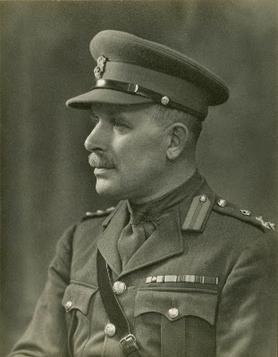
Major General George William Symes, was a senior British Army officer who served in the First World War, in which he was twice awarded the Military Cross. During the Second World War he commanded the 70th Infantry Division in India, and was deputy commander of the Special Force, commonly known as the Chindits, in Burma. He was deputy commander of the lines of communication of the 21st Army Group from May to November 1944, and then commanded the lines of communication in South East Asia Command (SEAC). In June 1945, he became general officer commanding (GOC) in Southern Burma.

The British Medical Association War Memorial, officially the War Memorial at British Medical Association House, Tavistock Square, Bloomsbury, London, commemorates men and women of the medical professions from the British Empire and Commonwealth who died in the Second World War. The memorial was commissioned by the British Medical Association and designed by the sculptor James Woodford. Unveiled in 1954 by Sir John McNee, then President of the BMA, and dedicated by Geoffrey Fisher, the Archbishop of Canterbury, it became a Grade II* listed structure in 1998.
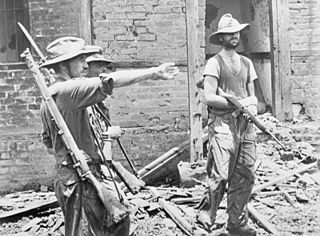
The Battle of Mogaung was a series of engagements that was fought in the Burma Campaign of World War II between 6 and 26 June 1944 at the Burmese town of Mogaung. In brutal fighting, the 77th 'Chindit' Brigade under Brigadier Michael Calvert, later assisted by Chinese forces of Generalissimo Chiang Kai-shek, fought for and captured the town from the occupying forces of Imperial Japan.

